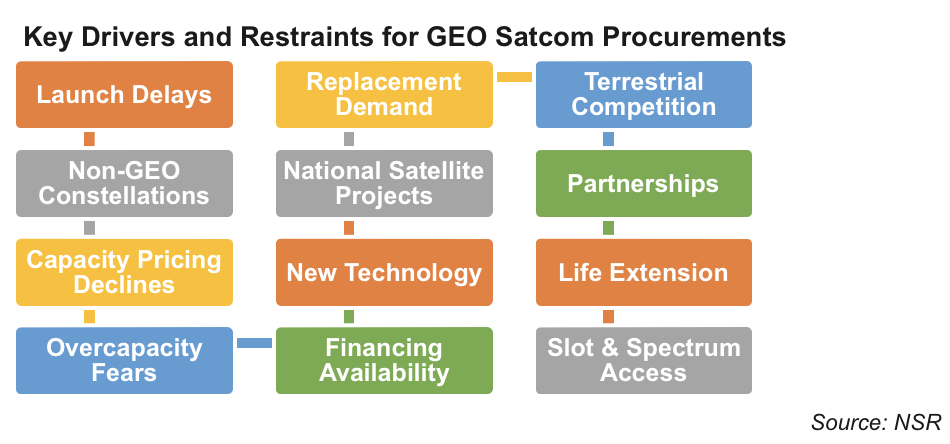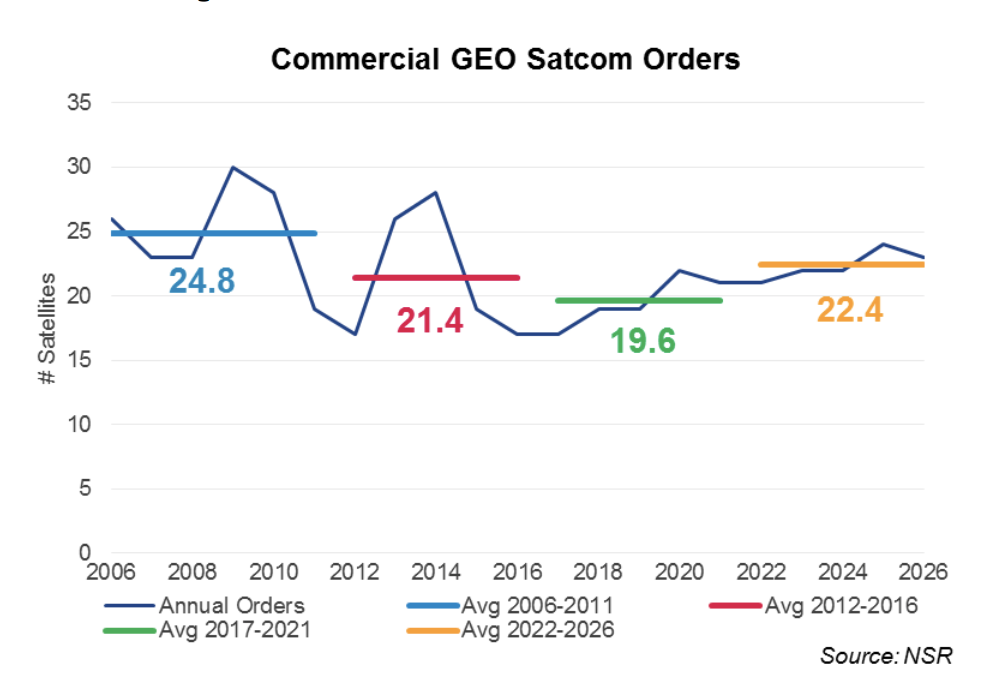Dim Light at
the End of the Tunnel?
Jun
19th, 2017 by
Carolyn Belle, NSR
For the last three years, satellite
manufacturers have struggled to win
orders and generate revenue in a down
market. Headwinds that emerged in 2015 –
launch access, financing availability,
insecurity about demand evolution, and
the threat of non-GEO systems – have
endured and intensified during 2016 and
2017, with few operators finalizing new
orders despite high RFP activity. While
satellite orders are expected to
increase, the evolving shape of demand
precludes a return to the ~25 satellite
orders average.

Ongoing Market Pressure
Pressure to optimize and (in many
cases) reduce CAPEX due to low capacity
pricing will not dissipate, limiting
orders to those with a robust business
case. Emerging solutions such as life
extension may become relevant for some
assets, particularly those serving
strong video neighborhoods, as operators
seek to lengthen CAPEX cycles. Yet as
the shape of data-driven demand
clarifies, operator confidence in ROI
should improve and alleviate this
restraint on contract finalization.
Lower Replacement Rate
The addition of HTS payloads and
increasing efficiency in transponders
per satellite, supported by advanced
platform design (e.g. power, payload
fraction), has significantly increased
per satellite capacity. Combined with
the implementation of electric
propulsion for orbit raising, a highly
capable satellite can be placed into
orbit for a fraction of the cost
feasible a decade ago. For operators
with multiple assets in the same or
clustered slots, it is possible to
replace multiple satellites with a
single new bird. With the greater cost
efficiencies of larger satellites, this
presents a compelling value proposition
for streamlined replacement – even if a
slot must be relinquished to
competitors.
While a prior concern with
concentrating capacity onto a single
bird was the risk of trapped capacity in
the face of evolving demand, advances in
flexible technology are helping
operators plan procurements with the
potential to adapt to a changing market.
The balance between capacity,
flexibility, and CAPEX will be unique to
each operator and each satellite
business case – we will not see every
bird going up with Tbps thoughput – but
overall trends point to a growing Mbps
per satellite moving forward: NSR
forecasts that HTS and hybrid HTS/FSS
satellites will grow to 70% of GEO
comsats ordered by 2026, a big jump from
53% in 2016.
Capacity Diversity- As MEO
constellations expand and LEO-HTS
constellations are developed, the GEO
market is adjusting to not being the
only game in town. For growing
applications like consumer broadband and
wireless backhaul, non-GEO will be in
direct competition with GEO. In many
other cases, this new capacity is
complementary to GEO, with SES,
Intelsat, Telesat, JSAT, and ViaSat
looking to cross-sell non-GEO and GEO
services to address diverse customer
requirements. With the surge in non-GEO
increasing competition as well as
filling out capacity portfolios, growth
in GEO demand is restrained.
Limited Customer Pool- Few new
players are expected to emerge in the
GEO space, generating only minimal added
demand. All GEO start-ups to date are
targeting data-centric, Ka-band HTS (and
moving forward, Q/V band) applications –
Kacific in 2017, Global IP in 2016. Some
may be successful and become regular
customers, while others (NewSat, 2011)
may fail to reach orbit.
Overall, NSR’s
Satellite Manufacturing and Launch
Services, 7th Edition
report found these factors culminate in
an average annual order rate of 20
satellites for the 2017-2021 time
period, growing to 22 satellites between
2022-2026 – both lower than the 24
satellites per year average before 2015.
This smaller addressable market will
challenge a growing set of manufacturers
looking to win contracts and fill their
factories.

For manufacturers able to win bids,
the more advanced capabilities and
flexible technology sought by operators
add a premium on average satellite cost,
compensating for the lower number of
orders when assessed from a macro market
size perspective.
The broader satellite marketplace
offers other opportunities to
manufacturers pinched by declining GEO
satcom demand, with the Science &
Technology Development and Non-GEO
Communications markets promising the
most revenue growth. While non-GEO
markets are still speculative as pieces
fall into place for mega-constellations,
they offer potential for a steady stream
of business due to faster replenishment
rates.
Lower order rates clearly have a
knock-on effect for launch service
providers; while still working through a
backlog of satellites ordered during
strong, pre-2015 years (a process
prolonged by several failures and
delays), lower order rates will heighten
already intensified competition as LSPs
aim to fill their manifests.
Bottom Line
The 2015-2017 dip in commercial GEO
satcom orders was largely a result of
temporary challenges; as operator
confidence in the market improves and
the launch environment stabilizes,
orders are expected to increase. Yet
ongoing market pressure, increasing per
satellite capabilities, and the
emergence of capacity diversity across
non-GEO and GEO imply that operators
will nonetheless procure fewer GEO
satellites than the historic norm. For
manufacturers, this means a light at the
end of the low order tunnel – but one
less brilliant than when they entered in
2015.

